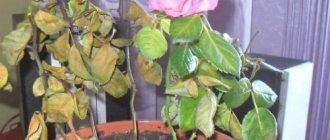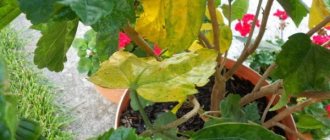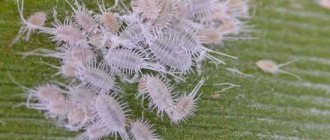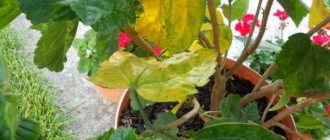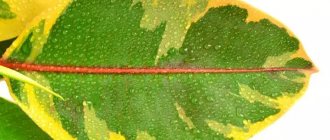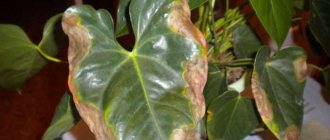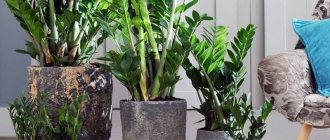Anthurium is an elegant indoor flowering plant that makes a great addition to any room. Another popular name is “male happiness.” Therefore, it is believed that in houses with this type of plant, representatives of the stronger sex will succeed and be happy. Although some people consider this flower to be fussy, it is easy to care for. It is enough to follow simple rules, and he will please the owner with his appearance. However, if you make a mistake in care, the plant will get sick. This can be determined by appearance. The appearance of yellow leaves is the first sign of problems. It is worth finding out how to determine the cause of yellowing and whether you should always worry, and also, if anthurium leaves turn yellow, what to do about it.
The appearance of yellow spots on anthurium: when to worry
The formation of yellow spots does not always indicate a disease or any problem. Sometimes this is a completely natural feature of the plant. If the care is correct, young, healthy, green leaves will appear regularly, and old ones will die off, so yellow leaves often appear on the stem. This is a natural process called aging. These old leaves just need to be removed, sometimes they fall off on their own.
Anthurium andreanum
Important! The number of such sheets is important: no more than 2-3 cases within one year. At the same time, there will definitely be new ones in their place. Otherwise, this is no longer natural aging, but a sign of illness and trouble.
Like other plants, anthurium can be stressed. It is caused by transplantation or moving to another location. Thanks to quality care, flowers can quickly return to their normal state and grow healthy. However, if the entire anthurium is covered with yellow spots, the leaves dry out, you need to find the cause of this condition and take measures to eliminate it, otherwise the flower will die.
Yellowed leaves on an anthurium
Often the cause of flower stress is precisely insufficient care. It can cause irreparable damage to plants. Therefore, it is important to quickly determine the cause of the problem. Plants of this species can also be infected by pests.
What are the causes of yellowness?
When healthy, anthuriums have smooth green or speckled leaves if they are compatible with the variety and do not show signs of yellowing. Leaf regeneration occurs quickly and new leaves develop without problems or damage. The flower should be provided with an optimal microclimate and care.
The main causes of yellowing leaves are:
- improper watering;
- Failure to observe regular fertilization intervals;
- too dry air;
- lighting errors.
A less common cause of yellowing anthurium leaves is lack of temperature control when storing the plant in a cold room for a long time. If these conditions are constantly violated, there is a risk of developing fungal diseases or rotting. They can even destroy the plant. Yellow spots on the leaves appear when attacked by insect pests that attack both above-ground parts and roots.
Why do anthurium leaves turn yellow?
The main reasons include: choosing the wrong pot, low humidity, excessive watering, too low or high room temperature. All of this could be the source of the problem. It is recommended to analyze and check each reason.
Location and influence of low temperature
Why anthurium does not bloom at home and what to do
The room should always be warm. If the room is less than +15 degrees or there are drafts, the flowers will suffer. Except for the yellow color, the leaves become too soft and limp.
Yellowness appears at the edges and gradually moves towards the middle of the plate. Then the leaves dry out and turn black. When the central heating system is switched off, a similar problem often occurs.
Diseases and pests
Pests often cause external changes in plants. They can also affect the root system, which poses a great threat to the life of anthurium. Leaves may turn yellow due to the following diseases:
- Gray rot. This disease can be caused by excessive indoor humidity. It all starts with a yellow coating, then it gradually turns white. It is important to detect the disease at an early stage so that flowers can be treated effectively and damage to them can be reduced.
- Septoria is caused by fungal infections. The spots on the plate grow quickly and spread over a large area. The leaf begins to fade.
- Anthracosis is associated with improper care during cultivation. The leaf becomes white, and only its tip turns yellow.
- Chlorosis occurs due to a lack of nutrients in the soil, such as magnesium or iron. The plant looks very dry, the dividing veins are not visible on the plate.
- Root rot is characterized by rapid development: leaves fall off in a few days due to the cessation of nutrient supply.
Important! To understand whether a pest is related to the health of the anthurium, it is necessary to carefully check each leaf at close range.
Plant pests
Yellowing after transplantation
Yellowing of leaves after transplantation occurs quite often. Errors in this process can deteriorate the condition of the flowers. If there are signs of yellowing after replanting, this means that the root system may be damaged. Due to its sensitivity, it is necessary to plant plants in the soil as carefully as possible. Complete replacement of soil with new soil is carried out only in severe cases.
Important! If flowers are bought in a store, all soil must be completely replaced. Then the anthurium should not be watered for the first 3 days to prevent the formation of rot.
Incorrect watering mode
Excessive humidity can cause leaves to turn yellow. Certain measures must be taken to eliminate excess moisture. The cause of rotting and yellowing may be:
- Too much water.
- Wrong choice of substrate.
- Using pots that are too large and making mistakes in choosing a drainage layer, which also causes stress to the plants.
Moreover, the danger lies not only in using too much water, but also not enough. Excessive dryness can also cause root rot. Yellowing begins at the edges of the leaves and moves toward the middle.
Planting in the wrong pot
If the chosen flower pot does not have room for roots to grow and develop, the plant will not grow and exist normally. Regular containers are not allowed for growing this plant. Only special flower pots are suitable for anthurium so that it can fully accommodate its roots. Otherwise the flower will slowly die.
Suitable pots for the plant
Lighting violation
The plant loves a lot of light. It can be in the twilight, but it does not feel very comfortable. Therefore, it is necessary to provide it with sufficient lighting. At the same time, bright direct light (especially sunlight passing through glass) can negatively affect growth and cause overheating.
Accordingly, yellowness may occur due to burns caused by exposure to sunlight. You can glue a special sun protection layer to the glass to solve this problem.
Important! Good light in sufficient quantities can be obtained with artificial lighting. But you don't need to install it next to flowers. The room just needs to be bright enough.
Lack of fertilizing and fertilizers
It is important not only to choose the right fertilizer to provide plants with enough additional food and vitamins, but also to use reasonable time intervals.
The active growing season of anthurium lasts from April to August, that is, most of the summer and spring. If you do not fertilize at this moment, the leaves will become covered with a yellow coating and will fall off over time.
Important! Over-fertilization is also dangerous, so all included instructions must be strictly followed.
What should be done for prevention so that the flower does not start to hurt
A sensitive tropical plant in favorable conditions develops and blooms well. Yellowing and wilting of the leaves indicates that the flower needs proper care. In order for an exotic culture to feel comfortable and not lose its decorative effect, it needs to create conditions that are close to natural.
Anthurium prefers long daylight hours of at least 10-12 hours , but does not tolerate direct rays of the sun. The air temperature should be between 18-25 °C in summer and 16-18 °C in winter. The room where the flower grows must be ventilated more often. It is important to provide the plant with protection from cold drafts.
Moderate watering and warm showers in summer are halved in winter. Nutrient supplements containing microelements are carried out twice a month during the growing season. During the rest period, the need for them disappears completely.
The plant prefers pots that match the volume of the root system. The planting container must have a hole in the bottom and be filled with a drainage layer and loose, fertile substrate.
Important! From time to time, exotic crops are inspected to identify dangerous pests. They can also cause the flower to yellow and wilt.
Changing the appearance of an indoor flower should not always cause panic and anxiety. However, a problem detected and corrected in time extends the life of the plant and preserves its decorative properties.
How to cure anthurium
Anthurium - home care: why leaves dry
Procedure if yellowing is detected:
- It is recommended to remove leaves that have turned yellow. This will help the plant recover faster.
- If the cause of deterioration is improper care, the situation must be improved. To do this, you need to install an air humidifier and strictly follow the watering and fertilizing plan.
- The flower must be replanted in strict accordance with all the rules, using only pots of the correct shape and size.
- If rot is the source of the problem, you need to remove the flowers from the pot, rinse the roots with warm water and carefully inspect them. Plants can be preserved by placing them in a disinfectant solution for 20 minutes. After this, the roots need to be dried, the plant should be transplanted into a new container and watered, wait until new leaves begin to grow.
Lighting is important for anthurium
Leaf senescence
The only cause of yellowing that does not require intervention or alteration is natural aging. As a result of this inevitable process, color change occurs on the lower leaves in close proximity to the ground.
The yellow color gradually spreads from the edges to the center. The leaf becomes less firm and juicy over time and then turns brown. After a few days it will dry out completely and fall off on its own.
With proper care, this natural process will not harm the plant, since young leaves will grow on it at the same time. During the process of wilting, the flower continues to spend its vital energy and nutrients to maintain the aging plates. Therefore, it is recommended to promptly remove the wilted parts to make life easier for the anthurium.
They should be cut with a sharp tool, and the cutting edge should first be disinfected with alcohol. Sprinkle crushed charcoal over the cut area to prevent infection. Fading, but still succulent leaves should not be torn off by hand, so as not to damage the plant.
Preventive measures
The lower leaves of phlox turn yellow: what to do
One of the main precautions is to regularly check for diseases and insect pests on anthurium. This will allow you to detect the first signs of a problem in time. It is also recommended to carefully follow the care instructions.
It is important to create the best and most suitable conditions for a comfortable life for plants. If traces of the disease are found on the surface, it is necessary to isolate the plant from other flowers to prevent spread. Compliance with precautionary measures will prevent the deterioration of the anthurium’s condition, allow you to quickly detect troubles and heal the flowers.
Yellowing of anthurium leaves can be caused not only by disease or improper care, but also by natural processes inside the flower. If this problem is discovered, you need to find the true cause, and then act immediately, do everything possible to save your house plants.
Pot size mismatch
As the plant grows, it needs room for a root system.
Once a year, preferably in the spring, the anthurium is transplanted into a larger pot. For good flowering, the volume of the container should be slightly larger than the size of the roots. In a large pot it is difficult to provide the necessary and sufficient level of moisture, so there is a high probability of yellowing of the leaves due to accumulated water. When replanting, it is important not to damage the fragile roots. If any of them are cut or damaged, they are treated with a special wood ash powder.
The container for planting must first be doused with boiling water.
First, the pot is filled 30% with drainage mixture. These can be various small stones or expanded clay. Then soil is poured for monocotyledonous flowering plants. Special breathable soil can be replaced with a mixture of turf, moss and fibrous peat soil in equal proportions.
Diseases and pests of the atrium
Yellowing of leaves is often the result of serious diseases to which the houseplant is susceptible. To combat them, it is important to know the external symptoms of the disease and ways to save the flower. This will help you recognize the cause of the problem and fix it in a timely manner.
The main diseases of anthurium:
Another reason for the yellowing of indoor anthuriums is their infestation by pests. In this case, you should carefully examine the flower. Aphids, mealybugs, mites and saxifrage can be found on leaf axes, on petioles or in close proximity to the ground.
If signs of the presence of insects appear, separate the infected plant from the rest and treat it with a soap solution adding 1 g of nicotine sulfate per liter of water. For the same purpose, you can use ready-made insecticides, diluting them according to the instructions. After 24 hours, rinse the plant with clean water and do not let it get wet in the soil.
Lack of humidity
Similar problems arise with anthuriums if they are placed in a room with dry air. The most common point at which the condition of flowers deteriorates is the beginning of the heating season. At this point, the usual conditions to which the plant is exposed change. Leaves and aerial roots do not receive enough nutrients and moisture from the environment.
Lack of nutrients causes the leaves of the plaque banks to turn yellow towards the center. These areas will then gradually dry out and the tips of the leaves will turn black. In a dry environment, young leaves cannot develop properly. They will grow misshapen and will not open correctly.
A home humidifier can help correct this situation. Use a humidifier to achieve a humidity level of 70-80%. If this device is missing, you can use improvised means. A wide, low bowl filled with water and fine gravel is placed next to the flower. The pot with the plant is placed directly in the ditch, but so that the root system does not have contact with moisture.
Lack of nutrition or excess of it
If the anthurium begins to grow slowly, the young foliage becomes smaller, it is worth thinking about the proper nutrition of the plant. For example, with a lack of phosphorus, potassium and nitrogen, the foliage becomes brown. Lack of magnesium and calcium also affects the body in the same way. You can feed the plant with ready-made liquid fertilizer - it is better to do this weekly so that the anthurium can recover. At the same time, for fertilizing, use ¼ of the fertilizer recommended by the manufacturer. When the anthurium gains strength, you need to switch to feeding once every two weeks.
Excess nutrition can also harm the plant. In this case, it is recommended to completely change the soil in the pot. If there is an excess of nutrition, young leaves grow too large and pale, and can take on different colors.
Root system diseases
Improper watering or low temperatures tend to damage the roots. They attack crushers, bacteria and fungi. If you suspect, take the plant out of the pot and carefully monitor the underground parts. If there are any rotten places, they should cut them off with a sharp, disinfected knife and dust charcoal cuts powder. Place the plant in a new container that is smaller in diameter than the previous one but matches the size of the root system.
If the damage is too severe, revive the plant:
- Damaged leaves are cut off. Treat healthy people with Epin or another growth stimulant.
- Rotten roots are cut off and destroyed. The remaining healthy parts are treated with fungicides and placed in a small container wrapped in pre-moistened sphagnum.
- Cover the anthurium with a plastic bag and place it under a phytolamp. Remove the lid daily and let the plant air out for 15 minutes. There is no need to water at this time.
- Once the roots have grown sufficiently, place the anthurium in fresh soil.
If the root system is completely destroyed by rot, it should be cut off and the stem placed in a jar of water with the addition of activated carbon. Once the roots have grown, repot the plant in a loose orchid mix and place in fresh soil.
Basic rules for flower care
Caring for anthurium is not so easy; it is important to bring the conditions of the apartment closer to its natural habitat, then it will grow intensively and bloom stably.
To do this, provide your exotic guest with good diffused lighting and protect him from sunburn. After adapting to apartment conditions, transplant the flower into a plastic pot, which will be 1-2 cm larger.
Do not cut off the aerial roots! Use purchased soil for Aroids or prepare it yourself using the method described above. Water the flower abundantly, but only after the top layer of soil has dried. It is better to do this using the bottom watering method. Spraying, sprinkling, and using a humidifier will help maintain the required humidity of 80%. Periodically inspect for pests and diseases. Treat if necessary.
The optimal temperature is 22-28⁰C. Fertilizing is applied once every 2-3 weeks during spring and summer. Use a specialized fertilizer according to the attached instructions or a weak infusion of mullein, humus.
Advice! Timely removal of old foliage and faded flower stalks will increase decorativeness and protect against fungus and pests.
Excess or lack of light
It is advisable to keep anthurium in partial shade - direct sunlight can cause burns on the leaves.
But it is also not recommended to place it in a too dark place - due to lack of lighting, the anthurium grows poorly and may not bloom. The leaves begin to turn pale from lack of light.
When there is an excess of light, anthurium leaves begin to turn yellow or may become bronze in color. You can also observe the appearance of brown spots on the tips of the leaves.
